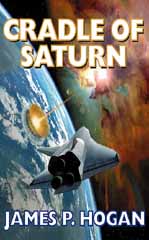
PROLOGUE
Times had always been plentiful. Since the beginning of the age when their ancestors
first walked in the world, the People had lived in harmony with the spirits and the
elements. Their language had no words for war or want, famine or drought.
The forests were vast, the plains fertile. Fair winds brought rain from warm oceans. All
of life flourished in abundance.
* * *
No memory had been handed down of where the People came from.
Some taught that they were born of Neveya, who ruled the skies during the times of
lesser light when the smaller but brighter Sun was absent, and at the end of mortal life
they would return to her across the Golden Sea in which the world floated. They learned to
farm the lands and tame animals; to study the ways of wood, and stone, and metals; to
admire and create music, likenesses, and things of beauty. Their sages pondered over the
mysteries of mind and the senses, life and motion, of number and the nature of things.
Communities grew under social imperatives and marketplaces for ideas, and became centers
of government and commerce.
* * *
Iryon stood near the mouth of a broad river, between arms of green hills rising to
distant mountains. It was not the largest of cities, but its buildings had been shaped and
ornamented with a care that made the whole as much an expression of art as the carved
gates and gilded window traceries, or the marble reliefs surrounding the central square.
At the summit of one of the five hills on which Iryon was built stood the Astral Temple,
where priests of Neveya charted the cycles of the heavens.
Each day began with the world looking out across the immensity of the celestial ocean
that extended away to Neveya's orb, dividing it equally like the plane of a blade halving
a water-fruit so that only the upper hemisphere of Neveya was visible. Then the Ocean
would rise, tilting and narrowing as it did so until it became an edge crossing past the
world to reveal briefly all of Neveya's countenance; from there, now above, it broadened
again to expand its underside, at the same time obscuring Neveya's upper part to reach its
half-day low, after which it would fall and cross back again. This cycle repeated 5,623
times in the year that the stars took to turn through their constellations.
The proportions of light and dark making up the days changed according to whether the
Sun was visible as well as Neveya, and in what situation—which varied with the
seasons. The "blue hours" came when the Sun shone from the far side of Neveya,
transforming its normally orange glow into a black shadow cast across the Golden Ocean. At
certain times in the course of the year, as the Ocean crossed past the world during the
blue hours, the Sun would vanish behind Neveya completely, turning day abruptly into
darkest night. These were the times when the other worlds that moved about Neveya revealed
themselves in their full glories of form and color. They were known as the days of
"Dark Crossings." Multitudes would come from afar to Iryon to attend the rites
and ceremonies that took place on these occasions.
* * *
The pyramid was built such that, from the Eye Stone at the center of the semicircle of
astronomers and priests where the Speaker of Neveya stood, the orb was seen as if
supported on its apex like a cloud grazing a mountain. Since Neveya never changed her
position in the sky, the disk remained balanced in that manner always, varying only from
yellow jewel through shrinking face to waning crescent as the Sun rode its distant course
about both her and the world, and the celestial Ocean rose and dipped through its daily
cycle. As the moment of the Dark Crossing approached, she glowered at the world with full
face, black and featureless, fading into the glare as the Sun touched her shoulder.
The crowds assembled on the slopes were hushed as the Speaker intoned the Verses of
Passage. Around the temple and across the city below, torches had been lit in readiness
for the Darkness. At the top of the pyramid, Neveya reappeared suddenly out of the glare
as a black arc sliding across the Sun, her shadow lying now like a black ray cut out of
the Ocean, moment by moment advancing closer. When it fell across the world, connecting it
to Neveya like a bridge spanning the Ocean, then, it was taught, the souls whose time had
come to return would depart on their journey.
A murmuring of awe and wonder, more a wind than a sound, stirred through the crowd as
the sky darkened. The astronomers readied their instruments and recording tablets, while
the Speaker turned, opening his robed arms wide to greet the spectacle. For an instant
Neveya's outline flared into a thin curve of light as if the extinguishing Sun were trying
to claw its way back around the edge. . . .
And then all the light went from the sky, and the stars appeared. Above and to one side
of Neveya, the pink globe of Jenas became visible, while beyond it Sephelgo's white-veined
features shone as crescents of crystal. Lower was Aniar, graying and mottled, swimming to
the side of Neveya, transfixed by the spear of the celestial sea seen edgewise, with the
white speck of Delem farther out still along the same line. As the astronomers peered and
recited their measures, scribes marked the stone that would later be cut for incorporation
into the records.
The picture showed a disk pierced by a shallowly sloping line, standing on an
arrowhead. Smaller circles showed the other visible worlds and their dispositions, with
major stars represented by their symbols. A table incised beneath the design gave precise
directions and elevations. |